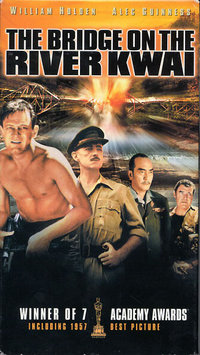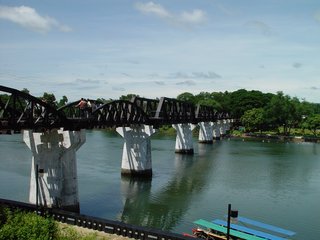The Bridge on the River Kwai
The Bridge over the River Kwai (French:Le Pont de la Rivière Kwai) is a novel by Pierre Boulle, published in 1952, that won France's "Prix Ste Beuve. more...
" It is a fictional story but it is based upon the real plight of Allied prisoners of war during World War II forced to build the 258-mile Death Railway by Japanese forces.
The Bridge on the River Kwai (1957) was a Anglo-American war film based on the book. It was filmed mostly in Ceylon (now Sri Lanka) near Kitulgala (close to a rest-house there today) with a few scenes shot in England.
The story is based on the building in 1943 of one of the railway bridges over the Kwai Yai at a place called Tamarkan five kilometres from the Thai town of Kanchanaburi. This was part of a project to link existing Thai and Burmese railway lines to create a route from Bangkok, Thailand to Rangoon, Burma (now Myanmar) to support the Japanese occupation of Burma. About a hundred thousand conscripted Asian labourers and 16,000 prisoners of war died on the whole project.
The destruction of the bridge in the film was accomplished by blowing up a full-sized bridge as a real train drove over it. This may have been the first time such a scene had been attempted without model shots since the silent film era. (Buster Keaton's The General includes an almost identical scene.)
One memorable feature of the movie is the tune that is whistled by the POW's—the "Colonel Bogey March"—and is now widely associated with the movie, and even sometimes referred to as the "River Kwai March." Besides serving as an example of British fortitude and dignity in the face of privation, it suggested (whether or not intended by the screenwriters) a specific symbol of defiance to many movie-goers of the period: WW II veterans (and many of their baby-boom sons) thought of the tune as that of a mockery of Japan's principal ally.
Fiction versus fact
Although the suffering caused by the building of the Burma Railway and its bridges is true, the incidents in the film are entirely fictional. The real senior Allied officer at the bridge was Lieutenant-Colonel Philip Toosey, who was a remarkable officer. The film is thought by many to be an insulting parody of a great man. Former prisoners have said that it is unlikely that a man like the fictional Nicholson could have risen to the rank of lieutenant-colonel. If he had, they said that he probably would have been quietly eliminated by the other prisoners.
Pierre Boulle, who had been a prisoner of war in Thailand, reportedly created the fictional Nicholson character as an amalgam of his memories of collaborating French officers. The film added David Lean's view of the Army, and Alec Guinness's interpretation of the character as mad.
The destruction of the bridge as depicted in the film is entirely fictional. In fact two bridges were built: a temporary wooden bridge and a few months later a permanent steel and concrete bridge. Both bridges were used for two years until they were destroyed by Allied aerial bombing. The steel bridge was repaired and is still in use today.
Read more at Wikipedia.org




